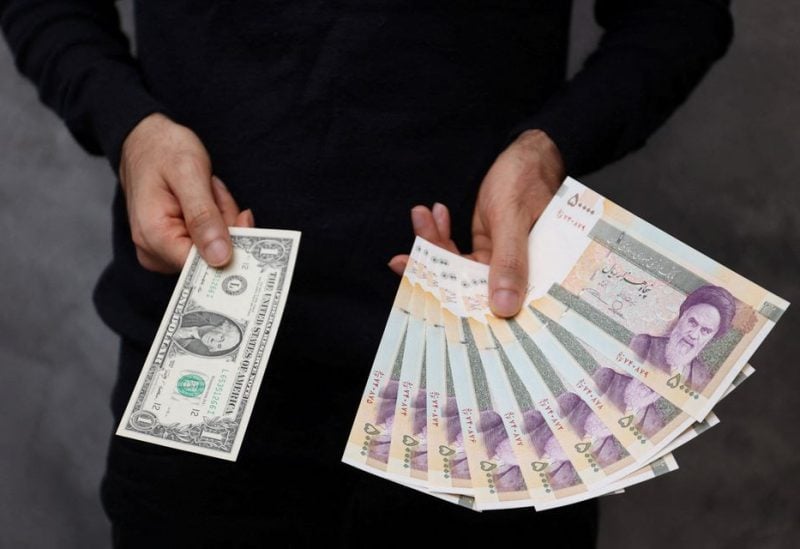
A currency dealer poses for a photo with a U.S one dollar bill and the amount being given when converting it into Iranian rials in an exchange shop in Tehran, Iran December 25, 2022. Majid Asgaripour/WANA (West Asia News Agency) via REUTERS
Iran’s Interior Minister Ahmed Vahidi has accused “enemies” of standing behind the devaluation of the Iranian rial against foreign currencies, especially the US dollar. The Central Bank of Iran (CBI) has taken measures to curb depositors’ demand for foreign currencies.
Iranians demanding foreign currencies is largely driven by worry over inflation and the country’s economic prospects.
On Sunday morning, the dollar price hiked to 600,000 riyals, but within a few hours, it fell to 580,000 riyals, according to the foreign exchange website Bonbast.com.
The dollar price had risen to 575,000 riyals in the free market on Saturday evening. This was hours after a closed session held by parliament in the presence of government officials to discuss the latest wave of record declines for the local currency. The price of the dollar had exceeded 540,000 on Friday.
Also, on Sunday, the euro price reached 630,000 riyals before slightly declining to stop at 610,000 riyals. The price of the pound sterling ranged between 690,000 riyals and 700,000 riyals.
Ehsan Khandouzi, the government spokesman for economic affairs who doubles as the minister of economic and financial affairs, told lawmakers in Saturday’s session that security forces had arrested “many manipulators whose aim was to disrupt the currency market.”
According to a parliamentary spokesman, the lawmakers criticized “contradictory policies” proposed by government officials for stabilizing the currency market and the dollar price.
Lawmaker Alireza Beigi revealed new details from the closed session and quoted Mohammad Mokhber, Iran’s first vice president, telling deputies that “we do not have a better way to manage the currency market. This is the way it is.”
Beigi slammed Mokhber’s statement as “very irresponsible,” especially since it came from a government official.
“Our impression from the economic team in the government is that it has no plan to get out of the current situation,” said Beigi.
Lawmakers also criticized CBI Governor Mohammad-Reza Farzin for requesting to expand his currency management powers.
Despite the criticism, Parliament Speaker Mohammad Bagher Ghalibaf said: “We have achieved good results in this meeting. God willing, we will overcome this problem by coordinating action with the government.”
Fluctuations in the dollar price have raised discontent among Iranians, who fear a new rise in commodity prices. The issue is hotly debated on social networks.
With annual inflation running at more than 50 %, Iranians are trying to protect the value of their savings by buying foreign currency or gold.
On Saturday, the CBI lifted a ban on private exchange shops selling hard currencies to calm the market and reduce the demand for the dollar.
Last week, the CBI opened an exchange center to allow ordinary Iranians to buy foreign currency, but some market analysts said the move had not yet dampened the appetite for dollars. Over the past six months, the Iranian currency has shed about 60 % of its value, according to Bonbast.
The Persian-speaking Farda Radio, which the US State Department funds, stated that the dollar price had jumped by 118% against the Iranian riyal since the last Iranian New Year, which was celebrated on March 20.
According to Reuters, the Iranian rial has lost nearly 45% of its value since nationwide protests erupted following the death of a young Iranian-Kurdish woman in police custody in September.
Iranian authorities fear that currency depreciation and the deterioration of the living situation will trigger renewed protests.
In a statement to Hamshahri daily, Vahidi said that recent currency events in Iran suggest that the country is facing a “conspiracy.”
“We do not see that economic reasons are only involved in the currency market’s inflammation, but rather it is a plot pursued by the enemy,” said Vahidi.
“When the enemy did not reach results in the riots, it intervened in the economic scene and the currency issue,” he added, explaining that Iran’s enemies want the currency crisis as a basis for stirring unrest.
“Inflation is one of our chronic economic problems,” said the minister.
“When we took over the government, inflation was 59%, then it decreased to 40%,” he claimed.
Currency traders say the rial’s slide is partly due to the protests, Tehran’s increasing isolation in the face of Western sanctions over its human rights record, and Russia’s use of Iranian-made drones in Ukraine.
Reinstating US sanctions in 2018 also harmed Iran’s economy by limiting its oil exports and access to foreign currency.
Moreover, nuclear talks between Iran and world powers to curb Tehran’s nuclear program in return for lifting sanctions have been stalled since September, worsening Iran’s economic prospects.
Nuclear negotiations faltered last March.
Iran’s previous government, headed by Hassan Rouhani, had faced accusations of raising the price of the dollar in the markets to cover a budget shortfall and save government expenditures.